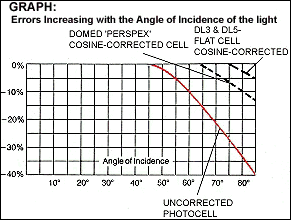As with most accurate test
equipment, initial calibration and routine recalibration must be done
properly; this is something we can carry out with speed and efficiency.
As you would expect Megatron instruments comply fully with the accuracy
requirements of BS667:2005 Specification for Portable Photoelectric
Photometers. A Calibration Certificate shows that the instrument has
been compared with Normals that have themselves been checked against
standards tested by the National Physical Laboratory; the instrument
calibration therefore complies with the common requirements that it
is to a "traceable standard". We recommend that instruments should be
returned to us on a regular basis for a calibration check and routine
servicing. We can calibrate nearly all types and makes of illuminance
meter and repair most of them.
Even with a lightmeter in
good repair, there are two other problems which can give rise to serious
inaccuracies.

1. Reflection from the
surface of the cell which increases as the angle of incidence increases,
so that the reading will be too low, eg. when measuring the horizontal
illuminance from a window at the far end of a room; this can give errors
of 20% or more
We use a "cosine correcting
mount" to correct this error; there are two basic types: the mount with
the clear 'Perpex' dome, and the photocell with a flat opal 'Perspex'
diffuser. As can be seen from the graph the flat cell gives rather better
results, but both methods are much better than using an uncorrected
cell.